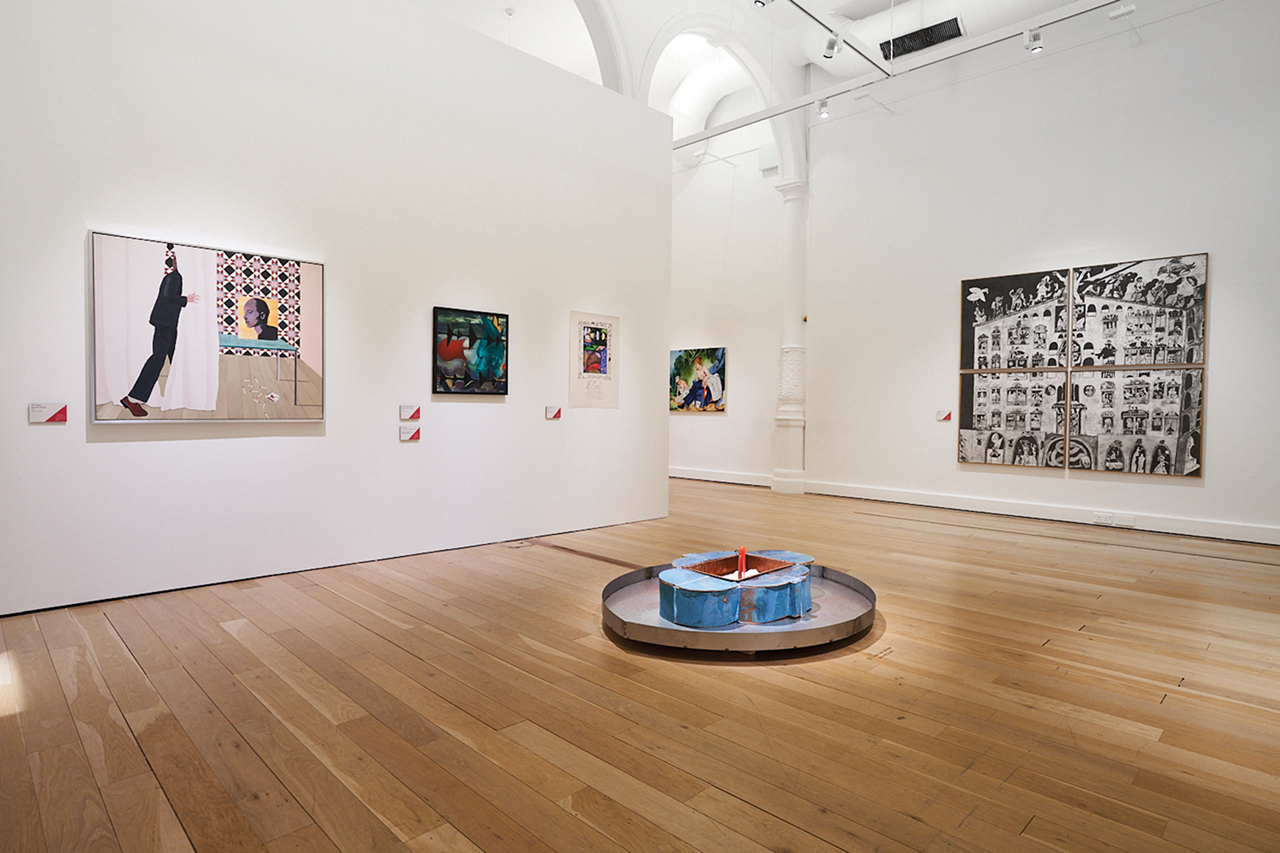The writer and curator Derek Horton says that Leeds Artists Show is “the first time since I arrived in Leeds in 1990 that the city’s artists have been given this level of visibility and recognition”. With fellow selectors – artist Hardeep Pandhal and writer Kadish Morris – Horton whittled submissions down to 90 participants.
In the foyer, Ian Kirkpatrick’s colourful Age of Silver is a fanfare for this extensive survey. His triumphal arch – clad with artificial black leather and embroidered patches of jet-fighters, cartoons, religious figures and myriad other iconography – reads as a satirical monument to globalisation. Rufus Newell’s large graphite drawing Hotel is equally extravagant, portraying the façade of a building occupied by communities of oddball characters, strange animals, and eccentric objéts d’art – each window a portal into a separate bohemian scene.
But the quieter works demand attention too, especially Florian Hynam’s No Pride in Assimilation, a small fabric banner printed with images from gay fetish magazines. Appliquéd across the surface in upper case, the title suggests gay culture is sanitised when assimilated into the heteronormative mainstream – perhaps more so now than in the nineties when documentaries like Emma Hindley’s Storm in a Teacup (1992) and Russell T Davies’ ribald drama Queer as Folk (1999) celebrated its countercultural status.
George Storm Fletcher’s contribution is a highlight. Two photographic works show messages inserted by Fletcher in the windows of houses. FIRST RULE OF ASSERTIVENESS: I AM ALLOWED TO CHANGE MY MIND reads one, in a maisonette. FORCE YOUR PARENTS TO MAKE FUNERAL PLANS reads another, in a bungalow. Though recalling the terseness of Jenny Holzer’s Truisms, they avoid her pessimism, instead dispensing a kind of citizen’s advice in a format associated with local activism – the out-on-a-limb protester using their home as a blank canvas.
JG Ballard once claimed that the contemporary art gallery isn’t an aesthetic realm but a laboratory for social experiments, a view that could describe Ronnie Danaher’s approach. Shown on a vertical screen encased in a white monolith, her video iConfess originates from a workshop whose participants were encouraged to confess their sins against a fictional religion called Dataism.
Far from being private communions with God, these secular confessions – made wearing homespun liturgical costumes in simulated cathedral-like environments – are public spectacles of self-abasement mocking the narcissism of social media: “I confess to using a VPN to hide my data from Data…”
As with David Steans’ Animation Monster – a short animation he commissioned from the Animation Monster studio, set in a fictional version of its office – digital media is both form and theme, its users and producers characterised in self-reflexive narratives that underline the insidiousness of this all-pervading technology. Some readers may remember Steans as the curator of Glamourie (2012) at Project Space Leeds, still one of the city’s best ever group shows.
Other videos document pieces performed to camera. Phee Jefferies’ Skin shows her naked body coated in clear latex, which exaggerates the skin’s ripples as she moves under studio lighting. Hannaa Hamdache’s Father Tongue is a spoken-word reflection on her Algerian-European heritage. As with Samuel Beckett’s monologue Not I, we see only Hamdache’s mouth as she offers observations that recall Stuart Hall’s claim that identity is discursively determined rather than defined by fixed origins.
Among the paintings, Judith Tucker’s Night Fitties, a series of crepuscular edgeland scenes, and Walid Elmahady’s faux-naïf portrait Birdman are just two of a strong showing. Among the sculptures, Paula Chambers’ Feminist Escape Route: Attempt No. 8 – a horse described with nothing more than a bridle, copper piping and long reins of pink rope delineating its backbone – stands out. As does Oliver Getley’s interactive cymbwheel, where seven cymbals are attached to wooden rods that you roll along the floor like surveyor’s wheels. I watched one visitor – I think she was a drummer – put them to the test. They didn’t produce the anticipated clangour, so if Bluetooth contact mics ever come on the market, Getley may be first in line.
There’s just enough space for a shout out to the 21 pupils from local schools, whose drawings and collages for Nicola Pemberton’s workshop The Wild Escape were a brilliant response to the theme of animals returning to the wild, and they show great promise in their combination of figurative and abstract elements. They mustn’t forget to put this show on their CVs.
Sean Ashton writes fiction, art criticism and poetry, and teaches fine art at Leeds Beckett University. His new novel The Way to Work is published by Salt and out now. Leeds Artists Show 2023 is at Leeds City Art Gallery until 30 April
Photos: Rob Battersby






Leave a reply
Your email address will not be published.